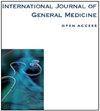Predictive Value of Simulated CT Radiomics Combined with Ipsilateral Lung Dosimetry Parameters for Radiation Pneumonitis in Patients with Esophageal Cancer: A Machine Learning-Based Retrospective Study
IF 2.1
4区 医学
Q2 MEDICINE, GENERAL & INTERNAL
引用次数: 0
Abstract
Objective: To explore how non-surgical esophageal cancer patients can identify high-risk factors for radiation-induced pneumonitis after receiving radiotherapy.Methods: We retrospectively included 228 esophageal cancer patients who were unable to undergo surgical treatment but received radiotherapy for the first time. By retrospective analysis and identifying potential risk factors for symptomatic radiation-induced pneumonitis (ie ≥grade 2), as well as delineating the affected lung as an area of interest on localized CT and extracting radiomics features, along with extracting dosimetric parameters from the affected lung area. After feature screening, patients were randomly divided into training and testing sets in a 7-to-3 ratio, and a prediction model was established using machine learning algorithms. Finally, the receiver operating characteristic (ROC) curve and decision curve analysis (DCA) were used to validate the predictive performance of the model.
Results: A total of 54 cases of symptomatic radiation pneumonitis occurred in this study, with a total incidence rate of 23.68%. The results of multivariate analysis showed that the occurrence of symptomatic radiation pneumonitis was significantly correlated with the mean lung dose (MLD), esophageal PTVD90, esophageal PTVV50, V5, V10, V15, and V20 in patients. The machine learning prediction model constructed based on candidate prediction variables has a prediction performance interval between 0.751 (95% CI: 0.700– 0.802) and 0.891 (95% CI: 0.840– 0.942) in the training and validation sets, respectively. Among them, the RFM algorithm has the best prediction performance for radiation-induced pneumonitis, with 0.891 (95% CI: 0.840– 0.942) and 0.887 (95% CI: 0.836– 0.938) in the training and validation sets, respectively.
Conclusion: The combination of localization CT radiomics features and diseased lung dosimetry parameters has good predictive value for radiation-induced pneumonitis in esophageal cancer patients after radiotherapy. Especially, the radiation-induced pneumonitis prediction model constructed using RF algorithm can be more effectively used to guide clinical decision-making in esophageal cancer patients.
Keywords: esophageal cancer, radiotherapy, radiation pneumonitis, radiomics, prediction model
食管癌患者辐射性肺炎的模拟 CT 放射组学与同侧肺剂量测定参数的预测价值:基于机器学习的回顾性研究
目的探讨非手术食管癌患者在接受放疗后如何识别放疗诱发肺炎的高危因素:我们回顾性地纳入了 228 例无法接受手术治疗但首次接受放疗的食管癌患者。通过回顾性分析,确定无症状放射性肺炎(即≥2级)的潜在危险因素,并在局部CT上将受影响的肺部划为关注区,提取放射组学特征,同时提取受影响肺部的剂量学参数。特征筛选后,按 7 比 3 的比例将患者随机分为训练集和测试集,并使用机器学习算法建立预测模型。最后,利用接收者操作特征曲线(ROC)和决策曲线分析(DCA)来验证模型的预测性能:本研究共发现 54 例无症状放射性肺炎,总发病率为 23.68%。多变量分析结果显示,症状性放射性肺炎的发生与患者的平均肺剂量(MLD)、食管PTVD90、食管PTVV50、V5、V10、V15和V20显著相关。根据候选预测变量构建的机器学习预测模型在训练集和验证集的预测性能区间分别为 0.751(95% CI:0.700- 0.802)和 0.891(95% CI:0.840- 0.942)。其中,RFM 算法对辐射诱导性肺炎的预测效果最好,在训练集和验证集中分别为 0.891(95% CI:0.840- 0.942)和 0.887(95% CI:0.836- 0.938):结论:定位CT放射组学特征与病变肺剂量学参数相结合,对食管癌患者放疗后放射性诱发肺炎具有良好的预测价值。关键词:食管癌;放疗;放射性肺炎;放射组学;预测模型
本文章由计算机程序翻译,如有差异,请以英文原文为准。
求助全文
约1分钟内获得全文
求助全文
来源期刊

International Journal of General Medicine
Medicine-General Medicine
自引率
0.00%
发文量
1113
审稿时长
16 weeks
期刊介绍:
The International Journal of General Medicine is an international, peer-reviewed, open access journal that focuses on general and internal medicine, pathogenesis, epidemiology, diagnosis, monitoring and treatment protocols. The journal is characterized by the rapid reporting of reviews, original research and clinical studies across all disease areas.
A key focus of the journal is the elucidation of disease processes and management protocols resulting in improved outcomes for the patient. Patient perspectives such as satisfaction, quality of life, health literacy and communication and their role in developing new healthcare programs and optimizing clinical outcomes are major areas of interest for the journal.
As of 1st April 2019, the International Journal of General Medicine will no longer consider meta-analyses for publication.
 求助内容:
求助内容: 应助结果提醒方式:
应助结果提醒方式:


